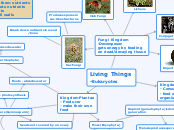Living Things
-Eukaryotes
Kingdom Plantae
- Producer
- make their own
food
Ferns (Pteridophyta)
Phloem - moves glucose
Xylem - absorbs water
Reproduce from spores
Conifers (Gymnosperm)
Roots - absorbs water
Leaves - photosynthesis
Seeds not covered by an ovary
Needle-like, scale-like leaves
Flower (Angiosperm)
Vascular
Monocot
1 seed leaf
Veins usually unbranched/
nearly parallel
Dicot
Grow 2 seed leaves
Single veins at the base
of the leaf blade
Tress, fruits, shrubs,
vegetables etc.
Flowers have male/female reproductive
organs
Reproduction
Seeds grow inside an ovary
When fertilized, flower falls away/
ovary swells to become a fruit
Moss (Bryophyta)
Haploid (gametophyte) is dominant generation
Meiosis produces spores; develop into M or F gametophytes
Non-Vascular
Hold water for a short period of time;
depend on moisture surrounding them
Fungi Kingdom
-Decomposer:
gets energy by feeding
on dead/decaying tissue
Club Fungi
Parasites on plants
Looks like umbrella growing from ground
Lichens
Fungus
Protects them from elements
Algae
Provides nutrients
Conjugation Fungi
2 separate mycelia produces spores
Asexual
Black Bread mold
Sac Fungi
Break down nutrients in wood
/bone
Produces spores in
sac-like structures
Imperfect Fungi
Reproduce asexually
Can be helpful to humans
Ex: Cyclyosporine (helps
immune system after
transplant surgery)
Kingdom Animalia
- Consumer
- feed on other
organisms
Invertebrates
Bilateral
Platyhelminthes
Planaria
- 2 Germ Layers
- Incomplete Digestion
- Motile
Mollusca
Squid
- 3 Germ Layers
- Complete Digestion
- Open Circulation
- Motile
Annelida
Earthworm
- 3 Germ Layers
- Complete Digestion
- Closed Circulation
- Motile
Arthropoda
Insects
- 3 Germ Layers
- Complete Digestion
- Open Circulation
Chordata
X-ray fish
- 3 Germ Layers
- Complete Digestion
- Motile
- Closed Circulation
Asymmetrical
Porifera
Sponge
- No Germ Layers
- No Digestion
- Diffusion
- Motile
Radial
Cnidaria
Jellyfish
- 2 Germ Layers
- Incomplete
Digestion
- Diffusion
- Motile
Echinodermata
Starfish
- 3 Germ Layers
- Complete Digestion
- Motile/Sessile
- Open Circulation
Vertebrates
- sexual
-complete digestion
Respiration through
Lungs
Mammalia
Human
- Small/Large
Intestines
- Central Nervous
System
Reptilia
Snakes
- Brain
- Small/Large
Intestines
Aves
Birds
- Central Nervous
System
Respiration through
Gills
Amphibia
Frogs
- Central Brain/
Spinal Cord
- Small/Large
Intestines
Chondrichthyes
Shark
- Brain and
Spinal Column
- Spiral valued
intestines
Osteichthyes
Catfish
- Brain and
Spinal Cord
- Stomach/
Small Intestine
